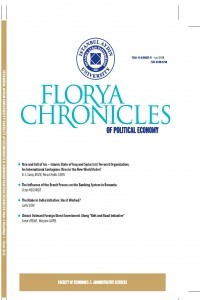Lord Curzon and the Use of Secret Intelligence at the Lausanne Conference: 1922-1923
Lord Curzon and the Use of Secret Intelligence at the Lausanne Conference: 1922-1923
Turkey’s “new” interest in the African continent has reached a level that merits academic investigation. There have been few if any robust study analyzing the social and economic dimensions of Turkey-Africa relations by employing technical methods. This paper aims to fill this gap by using a well established model within the discipline of international economics known as the “gravity model”. This model determines Turkey’s gravitational dynamics between specific African countries by examining pull and push factors. At the outset, however, a note of caution in relation to the use of this technical method is in order. When conducting technical research along this line, there are a number of potential problems to keep in mind, one of which relates to the reliablity and availability of data. This problem is probably the main reason for the scarce number of technical analyses in this area
Keywords:
Gravity Model, African Economies Turkey,
___
- [1] AA (2014), Turkey FM: Trade with Africa to hit $50 bn in five years, http://aa.com.tr/en/world/turkey-fm-trade-with-africa-to-hit50-bn-in-five-years/99677
- [2] Aglionby John et. Al, (2016), The reasons behind Turkey leader Recep Erdogan’s Africa tour, Financial Times, http://www.ft.com/cms/s/0/aaf3981a-27e5-11e6-8ba3- cdd781d02d89.html
- [3] Anderson, J. E. (1979). A theoretical foundation for the gravity equation. The American Economic Review, 69(1), 106-116.
- [4] Aybar, S. (2006). Potential of Africa and limits of Afropessimism. Paper presented at the 1st International TurkishAfrican Congress, Istanbul, Turkey.
- [5] Aybar, S. (2008a). Türkiye-Afrika ilişkileri (Turkey-Africa relatons). In Almanak 2007 Analizleri (pp. 353-373). Istanbul: Sosyal Araştrmalar Vakf (SAV).
- [6] Aybar, S. (2008b). Türkiye Afrika ekonomik ilişkileri (Turkey Africa economic relations). Stratejik Analiz, 99, [pages].
- [7] Aybar, S. (2009). Emerging Markets Global Players Report – Turkey, with University of Columbia, Vale Columbia Center.
- [8] Aybar, S. (2012). Turkish economy and the development of its financial sector. In S. Aybar & Y. Charalambides (Eds.), Turkey on the doorstep of Europe (pp. 32-39). Athens: Panteion University.
- [9] Bergstrand, J. H. (1985). The gravity equation in international trade: Some microeconomic foundations and empirical evidence. The Review of Economics and Statistics, 67(3), 474-481.
- [10] Bergstrand, J. H. (1989). The generalized gravity equation, monopolistic competition, and the factor-proportions theory in international trade. The Review of Economics and Statistics, 71(1): 143-153.
- [11] Bergstrand, J. H. (1990). The Heckscher-Ohlin-Samuelson model, the Linder hypothesis, and the determinants of bilateral intra-industry trade. The Economic Journal, 100(403), 1216– 1229.
- [12] Brautigam Deborah (2015), 5 Myths About Chinese Investments in Africa, Foreign Policy, http://foreignpolicy.com/2015/12/04/5-myths-about-chineseinvestment-in-africa/
- [13] Cramer, C., Johnston, D. & Oya, C. (2009). Briefing: Africa and the credit crunch: From crisis to opportunity? African Affairs, 108(433), 643–654. doi: 10.1093/afraf/adp058
- [14] Deardorff, A. V. (1995). Determinants of bilateral trade: does gravity work in a neoclassical world? NBER Working Paper No. 5377. Cambridge, MA: National Bureau of Economic Research. doi: 10.3386/w5377.
- [15] Glyn, A. (2006), Capitalism unleashed: Finance, globalization, and welfare (1st ed.). Oxford: Oxford University Press.
- [16] Hailu, D. (2008). Are the cheetahs tracking the tigers? Probing high growth rates in Africa. One Pager No. 70, Brasilia: International Poverty Centre–UN Development Programme.
- [17] Hausmann Jeannine and Erik Lundsgaarde (2015), Turkey’s Role in Development Cooperation, United Nations University, Centre for Policy Research Publication. [12] Brautigam Deborah (2015), 5 Myths About Chinese Investments in Africa, Foreign Policy, http://foreignpolicy.com/2015/12/04/5-myths-about-chineseinvestment-in-africa/
- 18] Numan Hazar (2003), Küreselleşme Sürecinde Afrika ve Türkiye-Afrika İlişkileri, Yeni Türkiye Yaynlar, Ankara.
- 19] Helpman, E., & Krugman, P. (1985). Market structure and foreign trade. Cambridge, MA: MIT Press.
- [20] Knowledge@Wharton (2016), China’s Investments in Africa: What’s the Real Story?, http://knowledge.wharton.upenn.edu/article/chinasinvestments-in-africa-whats-the-real-story/
- [21] IMF (2009, 2010), ‘Regional economic outlook, sub-saharan Africa’, IMF, Washington, DC.
- [22] Sabah (2015), No Going Back for Turkey – Africa Trade, http://www.dailysabah.com/money/2015/01/21/no-going-backfor-turkeyafrica-trade
- [23] Shinn David (2015), Turkey’s Engagement in Sub-Saharan Africa Shifting Alliances and Strategic Diversification, Chatham House Research Paper, London.
- [24] Sender, J., Cramer, C., & Oya, C. (2005). Unequal prospects: Disparities in the quantity and quality of labour supply in SubSaharan Africa. Social Protection Discussion Paper No. 0525. Washington, D.C.: The World Bank.
- [25] TIKA (2016), Turkey to host landmark World Humanitarian Summit, http://www.tika.gov.tr/en/news/turkey_to_host_landmark_worl d_humanitarian_summit-22648
- [26] Tinbergen, J. (1962). Shaping the world economy: Suggestions for an international economic policy. New York: The Twentieth Century Fund.
- [27] UNCTAD, (2014), Economic Development in Africa Report, New York, UN http://unctad.org/en/PublicationsLibrary/aldcafrica2014_en.pdf
- [28] Wilson, J., Pallister, D., & Lashmar, P. (2004, August 26). Thatcher and a very African coup. The Guardian. Retrieved fromhttp://www.theguardian.com/politics/2004/aug/26/uk.sout hafrica1.
- [29] World Bank. (2009a). Global development finance: Charting a global recovery. Washington, D.C.:The International Bank for Reconstruction and Development/The World Bank
- [30] World Bank. (2009b). Averting a human crisis during the global downturn: Policy options from the World Bank’s Human Development Network. Washington, D.C.:The World Bank.
- [31] World Bank (2013, 2015), Africa Competitiveness Report, WB, Washington DC, http://www.worldbank.org/content/dam/Worldbank/document/ Africa/Report/africa-competitiveness-report-2013-main-reportweb.pdf
- [32] World Bank (2014), Africa’s Pulse, WB, Washington DC, http://www.worldbank.org/content/dam/Worldbank/document/ Africa/Report/Africas-Pulse-brochure_Vol9.pdf.
- ISSN: 2149-5750
- Yayın Aralığı: Yılda 2 Sayı
- Başlangıç: 2015
- Yayıncı: İstanbul Aydın Üniversitesi
Sayıdaki Diğer Makaleler
Sanal Organizasyonların Yönetim Fonksiyonları Açısından Geleneksel Organizasyonlardan Farklılıkları
Food Security And Drawbacks Of Neo-Liberal Food Policies
Political Violence and Terrorism: Insight Into Niger Delta Militancy and Boko Haram
Özüm Sezin UZUN, Yusuf Saheed ADEGBOYEGA
Development as Systems: Systems Frameworks, Sub-Saharan African Development, and Health Systems
Psikolojik Sermaye Kavramı Üzerine Bir İnceleme
Economic Development In Africa: Salient Trends and Priorities
Relationship Between Political Instability & Growth In Some Selected Mena Countries
Lord Curzon and the Use of Secret Intelligence at the Lausanne Conference: 1922-1923
